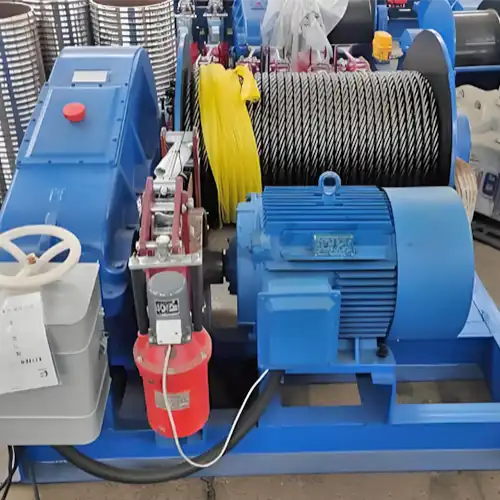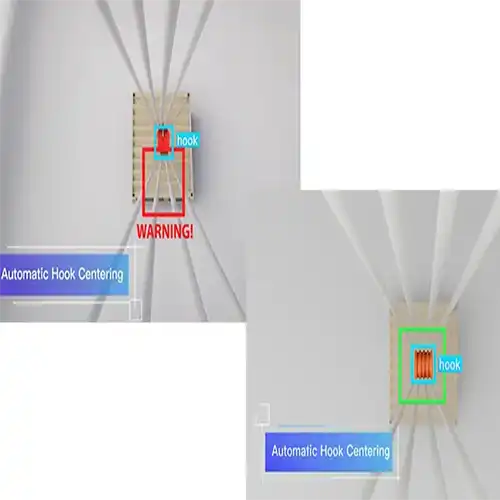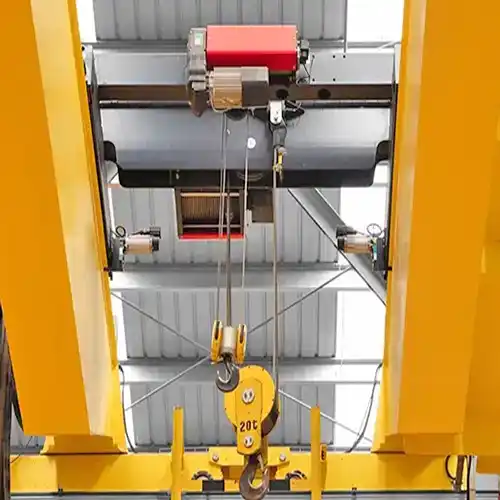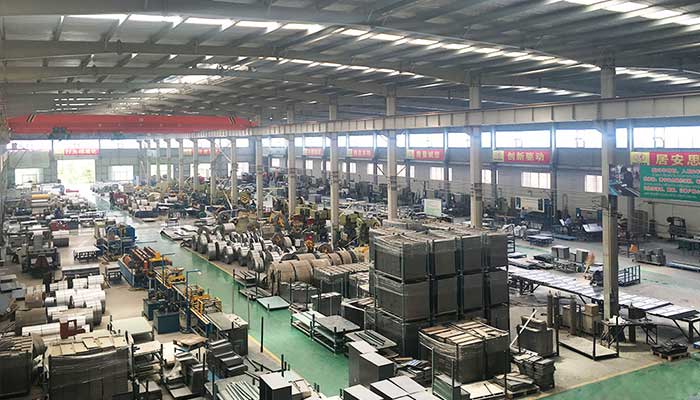
Electric Overhead Cranes and Hoists for Furniture Manufacturing
Overhead Cranes in the Furniture Industry
In the field world of furniture manufacturing, precision, efficiency, and quality are paramount. From raw materials to the finished products, each step requires meticulous handling to ensure that the final piece meets the highest standards. This is where the unsung heroes of the manufacturing world come into play: overhead cranes. In this blog, we delve into the realm of overhead cranes in the furniture industry, exploring how these mechanical marvels contribute to the creation of the furniture we love.
At the heart of the furniture industry lies an intricate web of material handling requirements. Furniture manufacturers deal with a diverse range of materials, from sturdy wood panels to delicate upholstery fabrics, and each of these materials demands careful transportation and positioning. This is where overhead cranes step in, offering a reliable and efficient solution to the complex challenges faced by furniture manufacturers.
With the constant pursuit of improved efficiency and innovation, the furniture industry has recognized the indispensable role that overhead cranes play in streamlining manufacturing processes. Whether it's lifting raw materials, facilitating assembly, or optimizing storage, overhead cranes are the backbone of material handling operations in this industry.
Overview of Furniture Industry
The furniture industry refers to the sector of the economy that involves the design, production, distribution, and sale of various types of furniture. Furniture encompasses a wide range of items used for different purposes, including residential, commercial, and institutional settings. This industry covers everything from basic functional pieces to more elaborate and decorative items. Common types of furniture include:
- Residential Furniture: This includes items for homes such as sofas, chairs, tables, beds, dressers, cabinets, and other pieces that people use in their living spaces.
- Office Furniture: Furniture designed for use in office settings, including desks, chairs, filing cabinets, conference tables, and office storage solutions.
- Commercial Furniture: Furniture used in businesses and commercial spaces such as restaurants, hotels, retail stores, and public waiting areas.
- Institutional Furniture: Furniture designed for use in institutional settings like schools, hospitals, libraries, and government buildings.
- Outdoor Furniture: Items designed for outdoor use, such as patio furniture, garden benches, and picnic tables.
- Specialty Furniture: This category includes furniture designed for specific purposes, like entertainment centers, home theaters, and specialized medical equipment.
The furniture industry involves various stages, including:
- Design: Designers create concepts and plans for furniture pieces, considering factors like aesthetics, functionality, ergonomics, and materials.
- Manufacturing: Manufacturers produce furniture according to the design specifications. This can involve various processes such as woodworking, upholstery, metalworking, and more.
- Distribution: After manufacturing, furniture is distributed to retailers, wholesalers, or directly to customers through various channels.
- Retail: Retailers sell furniture to consumers through physical stores or online platforms.
- Marketing and Sales: This involves promoting furniture products, showcasing their features, benefits, and unique selling points to potential customers.
- Maintenance and Repair: Furniture often requires maintenance and repair services to extend its lifespan and usability.
The furniture industry can be influenced by trends in design, materials, sustainability, and technology. It's a substantial global industry with both large manufacturers and smaller artisanal producers contributing to the market. As lifestyles and preferences evolve, the furniture industry adapts to meet changing demands and tastes.
Importance of Overhead Cranes for Furniture Industry
Overhead cranes are essential in the furniture industry for several reasons:
- Handling Heavy and Bulky Materials: Furniture manufacturing involves working with heavy and bulky materials such as wooden panels, metal frames, and upholstered components. Overhead cranes provide the lifting capacity needed to move these materials efficiently and safely.
- Efficient Material Movement: Overhead cranes allow for smooth and controlled movement of materials across different stages of production, from raw materials storage to assembly and packaging. This streamlines the manufacturing process and reduces the time required to complete tasks.
- Increased Productivity: By automating the lifting and moving of heavy materials, overhead cranes eliminate the need for manual labor-intensive tasks. This leads to higher productivity levels as workers can focus on more skilled and value-added tasks.
- Improved Workplace Safety: Manual lifting of heavy furniture components can lead to injuries and strains for workers. Overhead cranes reduce the risk of accidents and injuries by providing a safe and controlled method of material handling.
- Accurate Positioning: Overhead cranes enable precise positioning of materials, which is crucial for assembly and manufacturing processes. This accuracy helps ensure that furniture components fit together correctly and that finished products meet quality standards.
- Versatility: Different types of overhead cranes can be tailored to specific needs within the furniture industry. Whether it's moving large pieces, transporting materials between workstations, or aiding in assembly, overhead cranes offer versatility in material handling tasks.
- Time and Cost Savings: Overhead cranes expedite material movement, reducing the time needed for tasks such as loading and unloading trucks, positioning materials for assembly, and transferring components within the facility. This efficiency translates into cost savings over the long term.
- Handling Irregular Shapes: Furniture components often come in various shapes and sizes. Overhead cranes equipped with appropriate lifting attachments can handle irregularly shaped items with ease.
- Optimal Use of Space: Overhead cranes operate in the vertical space above the workspace, which allows for optimal use of floor space. This is particularly important in manufacturing facilities with limited space.
- Support for Customization: In the furniture industry, custom pieces are common. Overhead cranes aid in the movement of components needed for customization, ensuring that unique pieces are assembled accurately.
- Reduced Material Damage: Overhead cranes provide gentle and controlled lifting and movement, reducing the risk of damage to fragile or sensitive furniture materials.
- Sustainability and Ergonomics: Overhead cranes can contribute to a more sustainable work environment by reducing manual labor and minimizing waste. Additionally, they promote ergonomic work practices by minimizing the physical strain on workers.
In summary, overhead cranes play a crucial role in the furniture industry by enhancing efficiency, safety, and productivity in material handling processes. They are an investment that leads to long-term benefits and improved overall operations within furniture manufacturing and distribution facilities.
Types of Overhead Cranes
When it comes to handling the diverse demands of the furniture manufacturing industry, overhead cranes come in various forms, each tailored to specific needs. Let's explore the world of overhead cranes, starting with the versatile Bridge Cranes, which include Single Girder Bridge Cranes and Double Girder Bridge Cranes, which also can be customized into European style overhead crane and economical Chinese style bridge crane. If you have any need, please feel free to contact us.
Bridge Cranes
Bridge cranes are the workhorses of material handling, designed to move materials horizontally along the overhead runway. They are commonly seen in manufacturing facilities due to their ability to cover wide areas and their versatility in carrying out different tasks.
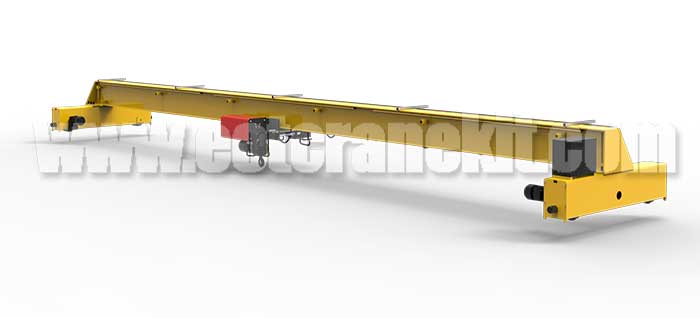
- Features, Benefits, and Lifting Capacity: Single Girder Bridge Cranes are known for their compact design and cost-effectiveness. They feature a single horizontal beam that spans the width of the workspace. These cranes are suitable for lifting capacities ranging from light to moderate loads.
- Functions and Applications in Furniture Manufacturing: Single Girder Bridge Cranes are particularly well-suited for tasks that involve moving materials from one workstation to another. They efficiently transport furniture components during various stages of manufacturing, such as raw material handling, cutting, shaping, and assembly.
- Typical Workstations and Tasks: These cranes can be stationed at cutting tables, assembly lines, and finishing areas. They aid in the movement of wood panels, metal frames, and upholstery materials, contributing to the seamless flow of the manufacturing process.
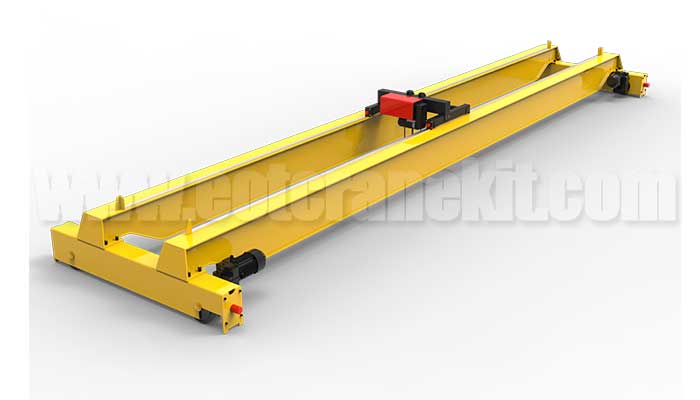
- Features, Benefits, and Lifting Capacity: Double Girder Bridge Cranes are the heavy-duty counterparts of single girder cranes. They have two horizontal beams for enhanced stability and can handle higher lifting capacities.
- Functions and Applications in Furniture Manufacturing: Double Girder Bridge Cranes shine in tasks that involve handling heavier loads and larger furniture components. They are indispensable in moving substantial pieces like cabinetry, large wooden structures, and sizable upholstery materials.
- Handling Heavier Loads and Larger Components: Double Girder Bridge Cranes are essential for lifting and positioning bulkier furniture elements during manufacturing. Their robust design and higher lifting capacity ensure that even the most substantial pieces can be moved with precision.
Electric overhead cranes and bridge cranes, whether single or double girder, are integral to the furniture industry. They enhance efficiency, minimize manual labor, and contribute to the overall quality of the final products. In the world of material handling, these cranes are the architects of smooth and streamlined furniture production processes. In the next section, we'll explore another crucial category: Jib Cranes, designed for precision in tight spaces and specific workstations.
Jib Cranes
In the realm of overhead cranes, Jib Cranes stand out for their ability to provide precision in confined spaces. They are designed to lift and move materials within a limited area, making them indispensable for specific workstations and tasks in furniture manufacturing.
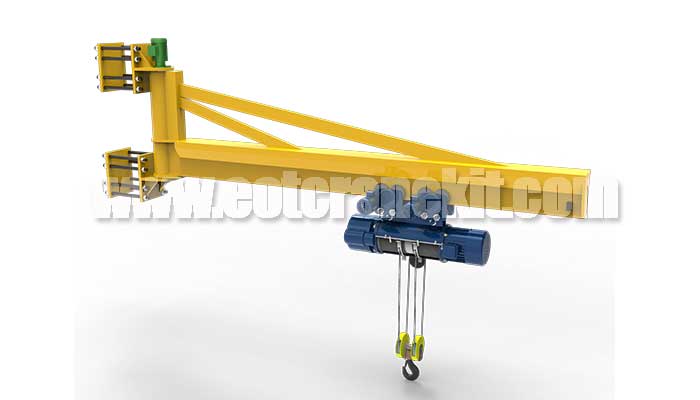
- Features and Benefits: Wall-Mounted Jib Cranes are known for their space-saving design. They are affixed to walls or columns, leaving the floor area free for other operations. Their compact structure allows for easy integration into existing spaces.
- Functions and Applications in Furniture Assembly: Wall-Mounted Jib Cranes excel in tasks that require precise positioning of smaller components during furniture assembly. They aid in lifting and placing intricate parts with accuracy and ease.
- Precision Positioning of Smaller Components: These cranes are perfect for tasks that demand careful handling of delicate upholstery materials, hardware, and connectors. Their ability to pivot and extend allows operators to reach tight spots effortlessly.
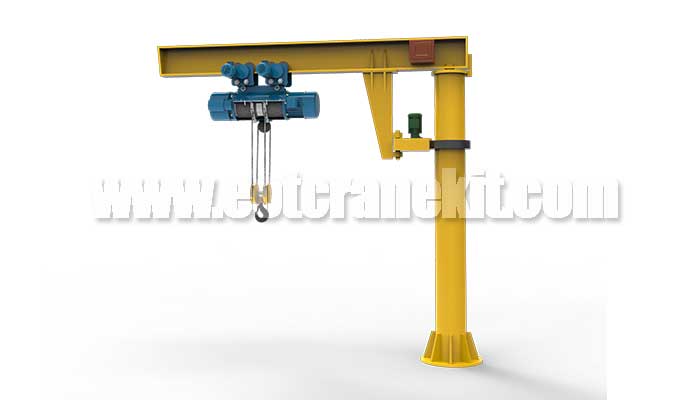
- Features and Benefits: Free-Standing Jib Cranes offer a versatile solution for material handling. They are not dependent on existing structures, making them ideal for areas without walls or columns for mounting. Their 360-degree rotation provides excellent coverage.
- Functions and Applications in Material Handling: Free-Standing Jib Cranes are the go-to choice for moving materials across various points in the workspace. They facilitate the transfer of components to and from workstations, enhancing overall productivity.
- Versatility in Positioning Materials: These cranes can be strategically positioned to serve multiple workstations. From raw material storage to assembly lines, Free-Standing Jib Cranes streamline material movement, reducing the need for manual lifting.
Jib Cranes, whether wall-mounted or free-standing, bring finesse to material handling tasks in the furniture industry. Their ability to provide precision and flexibility makes them invaluable for specific operations. As we continue our exploration, we'll delve into the world of Gantry Cranes, which play a pivotal role in efficiently managing larger spaces and handling heavy loads. Stay tuned for insights into their features, applications, and benefits.
Gantry Cranes
Gantry Cranes are the juggernauts of the material handling world, designed to tackle large spaces and heavy loads. Let's explore the two main categories of Gantry Cranes that play crucial roles in the furniture industry.
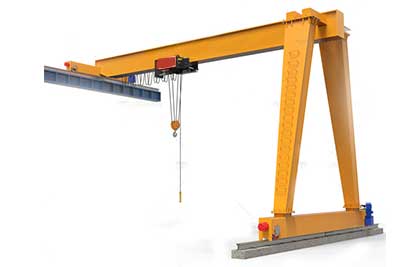
- Features, Benefits, and Lifting Capacity: Single Leg Gantry Cranes are known for their single supporting leg, which leaves ample space beneath for unobstructed movement. They offer high lifting capacities and can cover vast areas while maintaining stability.
- Functions and Applications in Furniture Warehouses: Single Leg Gantry Cranes shine in warehousing operations, where efficient material movement and storage are critical. They facilitate the loading and unloading of raw materials and finished products.
- Efficient Use of Limited Floor Space: These cranes optimize floor space, making them suitable for furniture warehouses with restricted room for maneuvering. The single leg design ensures that the workspace remains uncluttered and organized.
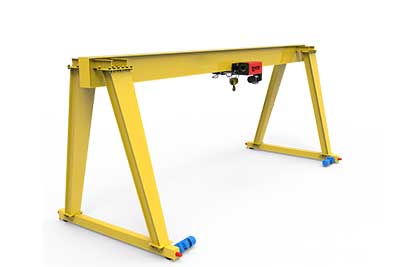
Double Leg Gantry Cranes with single girder or double girder design
- Features, Benefits, and Lifting Capacity: Double Leg Gantry Cranes boast enhanced stability with two supporting legs. Their sturdy construction allows them to handle even heavier loads while maintaining balance.
- Functions and Applications in Heavy-Duty Tasks: Double Leg Gantry Cranes are the workhorses for heavy-duty tasks in furniture manufacturing. From lifting substantial components to moving large furniture pieces, they excel in managing substantial loads.
- Stability and Load Distribution: The two-leg design ensures load distribution and stability, making these cranes ideal for operations that involve moving heavy furniture components and structures.

Monorail Cranes provide a unique solution for linear material movement within the furniture manufacturing process. Let's explore one of the notable subtypes of Monorail Cranes: Monorail Bridge Cranes.
- Features and Benefits: Monorail Bridge Cranes feature a single rail along which the crane moves, allowing for linear material transport. They provide precise control over material movement, making them ideal for specific tasks.
- Functions and Applications in Linear Material Movement: Monorail Bridge Cranes are invaluable when materials need to move in a straight line. They facilitate the movement of furniture components from one workstation to another along a predefined path.
- Applications in Transporting Furniture Components: These cranes find applications in transporting furniture components between different stages of the manufacturing process. Their linear movement ensures that materials are guided accurately.
Stacker Cranes
Stacker Cranes offer an automated solution for efficient material storage and retrieval. Let's explore the capabilities of Automated Stacker Cranes in optimizing material handling within furniture manufacturing.
- Features, Benefits, and Automation Capabilities: Automated Stacker Cranes are designed for high-density storage systems. They are equipped with automation technology, allowing them to autonomously retrieve and store materials with precision.
- Functions and Applications in High-Density Storage: These cranes excel in environments where space optimization is paramount. They efficiently retrieve and store furniture components in stacked storage, minimizing the footprint.
- Optimizing Material Retrieval and Storage: Automated Stacker Cranes enhance efficiency by reducing the time required for material retrieval. They contribute to a seamless workflow by ensuring that the right materials are readily available.
From the vast areas of warehouses to the intricacies of linear material movement and high-density storage, Gantry Cranes, Monorail Cranes, and Stacker Cranes are the unsung heroes that optimize the furniture manufacturing process. As we continue our journey through the world of overhead cranes in the furniture industry, we'll explore their roles in enhancing efficiency, safety, and overall productivity. Stay tuned for more insights into these mechanical marvels.
Key Features and Benefits
As we delve deeper into the realm of overhead cranes in the furniture industry, it's essential to understand the key features and benefits that make these machines indispensable for modern furniture manufacturing. Let's explore how these cranes contribute to the efficiency, precision, and safety of the production process.
- Durability and Reliability for Continuous Operation: Overhead cranes are built to withstand the demands of the furniture industry's rigorous material handling tasks. Their robust construction ensures they can handle repetitive lifting, transporting, and positioning of components without compromising performance.
- Precise Positioning for Accurate Assembly and Processes: Precision is paramount in furniture manufacturing. Overhead cranes offer precise control over material movement, allowing operators to position components with accuracy during assembly. This precision minimizes errors and enhances the quality of the final products.
- Safety Features and Considerations: Safety is a non-negotiable aspect of any manufacturing environment. Overhead cranes are equipped with safety features such as limit switches, overload protection, and emergency stop controls. These features mitigate the risk of accidents and ensure the well-being of operators and the workplace.
- Flexibility and Adaptability to Different Tasks: Furniture manufacturing involves a wide array of tasks, from lifting heavy materials to delicately positioning upholstery fabrics. Overhead cranes are designed with versatility in mind, allowing them to adapt to various tasks and handle different materials without compromising efficiency.
- Enhanced Efficiency and Productivity: Overhead cranes streamline material handling operations, reducing manual labor and expediting processes. They eliminate the need for time-consuming manual lifting and transportation, leading to improved overall efficiency and productivity.
- Reduced Operator Fatigue: Manual lifting of heavy components can lead to operator fatigue and potential injuries. Overhead cranes alleviate this burden by handling the heavy lifting, allowing operators to focus on precise positioning and other essential tasks.
- Optimized Use of Workspace: Overhead cranes operate above the workspace, maximizing floor space for other manufacturing processes. This optimization of space is particularly valuable in facilities with limited room for maneuvering.
- Customizable Solutions: Overhead cranes can be tailored to suit the specific needs of the furniture industry. Whether it's designing specialized lifting attachments or integrating automation capabilities, these cranes can be customized to enhance the production process.
- Long-Term Cost Savings: While the initial investment in overhead cranes may seem substantial, their long-term benefits far outweigh the costs. They contribute to increased production efficiency, reduced material damage, and minimized downtime, resulting in significant cost savings over time.
In the fast-paced world of furniture manufacturing, overhead cranes act as reliable partners that enable smoother operations, precise assembly, and enhanced safety. From lifting heavy wooden panels to delicately positioning upholstery materials, these cranes play a pivotal role in shaping the future of furniture production. As our exploration continues, we'll delve into the specific applications of overhead cranes within the various stages of furniture manufacturing. Stay tuned for more insights into their practical impact on the industry.
Applications in Furniture Manufacturing
In the intricate world of furniture manufacturing, the seamless orchestration of processes is paramount to create the exquisite pieces that adorn our living spaces. Overhead cranes, like skilled conductors, play a crucial role in harmonizing these processes. Let's explore the multifaceted applications of overhead cranes within the various stages of furniture manufacturing:
Raw Material Handling and Storage
Raw materials are the foundation of every furniture piece. Overhead cranes expertly lift, move, and position materials such as wooden panels, metal frames, glass sheets, and upholstery fabrics. They facilitate the organized storage of these materials, ensuring that the right components are readily available for production.
- Typical Overhead Crane: Bridge Cranes (Single Girder or Double Girder)
- Function: Bridge cranes are used to move raw materials such as wooden panels, metal frames, and upholstery materials from storage areas to workstations.
- Benefits: These cranes offer high lifting capacity and the ability to cover a wide area, facilitating efficient material movement and storage.
Cutting, Shaping, and Assembly Processes
Precision is the hallmark of quality furniture, and overhead cranes are instrumental in achieving it. These cranes transport materials to cutting and shaping stations with accuracy, facilitating the creation of components with precise dimensions. During assembly, overhead cranes aid in positioning and joining components seamlessly.
- Typical Overhead Crane: Bridge Cranes (Single Girder or Double Girder)
- Function: Bridge cranes are used to transport materials to cutting and shaping machines, ensuring accurate positioning and smooth material flow.
- Benefits: Precision positioning helps maintain product quality, and the cranes handle heavy loads effectively.
Finishing and Upholstery Stages
As furniture pieces take their final form, overhead cranes continue to play a significant role. Delicate upholstery fabrics require careful handling, and these cranes ensure their precise positioning. In finishing stages, overhead cranes transport components for painting, staining, and applying protective coatings, ensuring a flawless appearance.
- Typical Overhead Crane: Jib Cranes or Bridge Cranes (Single Girder)
- Function: Cranes assist in moving furniture components to finishing and upholstery stations, ensuring precise placement for these detailed processes.
- Benefits: Cranes help maintain quality by positioning components accurately for finishing and upholstery work.
Packaging, Shipping Preparation, and Distribution
The journey doesn't end with the completion of furniture pieces—it extends to their safe delivery. Overhead cranes contribute to packaging and shipping preparations by moving finished products to packaging stations. They facilitate efficient loading onto delivery trucks, ensuring products reach their destinations in pristine condition.
- Typical Overhead Crane: Bridge Cranes (Single Girder or Double Girder)
- Function: Cranes are used to transport finished furniture components to packaging and shipping areas, facilitating efficient packing and preparation for shipment.
- Benefits: Cranes aid in the movement of finished products without causing damage and enable efficient packaging processes.
Customization and Modifications for Unique Pieces
Every furniture piece has its own story to tell. Overhead cranes assist in handling customized components and modifications, seamlessly integrating unique elements into the manufacturing process. Whether it's a one-of-a-kind design or a tailored alteration, these cranes ensure the individuality of each piece.
As versatile performers on the manufacturing stage, overhead cranes play diverse roles, each crucial in crafting the perfect piece of furniture. Their strength, precision, and adaptability ensure that raw materials are transformed into beautifully crafted items that grace homes, offices, and public spaces. In the next section, we'll unravel the considerations that guide the selection of the right overhead crane for specific tasks, providing insights into the factors that contribute to optimal performance and efficiency. Stay tuned for a closer look at the decision-making process behind these mechanical marvels.
Considerations for Selection: Choosing the Right Overhead Crane
Selecting the appropriate overhead crane for a specific task within the furniture manufacturing industry requires careful evaluation of various factors. The decision-making process involves assessing the unique needs of the operation to ensure optimal performance, efficiency, and safety. Let's delve into the key considerations that guide the selection of the right overhead crane:
- Capacity: Determining the lifting capacity is essential. The crane must be capable of handling the heaviest loads expected in the operation. It's important to account for potential load variations and ensure that the crane can comfortably handle them.
- Span: The span refers to the distance between the runways or supporting structures. The span should be sufficient to cover the area where the crane will be used, allowing for free movement and effective material handling.
- Clearance Height: The vertical distance between the crane's highest point and any potential obstructions must be considered. This ensures that the crane can operate without any hindrances and that the load can be lifted to the required height.
- Material Type and Size: The characteristics of the materials being handled, such as weight, dimensions, and fragility, impact the choice of crane. Cranes must be able to lift and transport materials safely, without causing damage.
- Automation Level: The level of automation required depends on the nature of the operation. Automated features such as remote controls, load sensing, and precision positioning can enhance efficiency and reduce manual labor.
- Work Environment: Environmental factors like temperature, humidity, and corrosive elements can influence the crane's performance and longevity. It's crucial to choose cranes that are designed to withstand the specific conditions of the workspace.
- Safety Features and Compliance: Safety is paramount. Look for cranes equipped with features such as overload protection, emergency stop buttons, and collision avoidance systems. Ensure that the chosen crane complies with industry safety standards.
- Operator Training and Maintenance: Proper training for crane operators is essential to ensure safe and efficient operation. Additionally, consider the maintenance requirements of the crane. Regular maintenance and inspections are necessary to keep the crane in optimal working condition.
The selection of the right overhead crane involves a holistic assessment of these considerations. Each factor plays a crucial role in determining the crane's suitability for the intended application. By carefully evaluating these aspects, furniture manufacturers can make informed decisions that align with their production needs, enhance efficiency, and prioritize safety.
In the next section, we'll explore how overhead cranes can be tailored to meet the unique requirements of the furniture manufacturing industry. Stay tuned as we uncover the ways in which these cranes can be customized to optimize material handling processes and support the creation of exceptional furniture pieces.
Tailored Solutions for Furniture Industry: Enhancing Efficiency and Aesthetics
In the ever-evolving world of furniture manufacturing, the quest for efficiency, precision, and innovation drives continuous improvement. Overhead cranes, versatile as they are, offer more than off-the-shelf solutions. They can be tailored to meet the unique demands of the furniture industry, optimizing material handling processes and seamlessly integrating into the workspace. Here's a closer look at how these cranes can be customized for enhanced performance:
Custom Lifting Attachments for Different Components
No two furniture components are exactly alike, and the way they are handled matters. Custom lifting attachments can be designed to suit specific materials, shapes, and sizes. Whether it's a gentle sling for upholstery fabrics or a specialized clamp for delicate wooden components, these custom attachments ensure secure and damage-free handling throughout the manufacturing process.
Integration with Existing Production Processes
Seamless integration is key to maintaining a well-orchestrated manufacturing environment. Overhead cranes can be tailored to align with existing production workflows. By strategically positioning cranes at critical points along the assembly line, materials can be effortlessly transported, enhancing production efficiency and reducing bottlenecks.
Aesthetic Designs to Complement Workspace
Functionality need not sacrifice aesthetics. Overhead cranes can be designed with a keen eye on visual appeal, ensuring they seamlessly blend into the workspace. Aesthetic considerations can include color coordination, sleek profiles, and minimalistic designs, making these industrial tools an integral part of the workspace's overall design.
Customization extends beyond functionality—it's about creating an environment where efficiency and aesthetics coexist harmoniously. By tailoring overhead cranes to the unique needs of the furniture industry, manufacturers can unlock a range of benefits:
- Enhanced Efficiency: Custom solutions streamline material handling, reducing the time and effort required for each task.
- Reduced Material Damage: Custom lifting attachments minimize the risk of material damage during handling, preserving the quality of components.
- Improved Safety: Tailored cranes can incorporate advanced safety features specific to the furniture industry's requirements, ensuring the well-being of operators and preventing accidents.
- Optimized Space Utilization: Integration with existing processes and the use of space-efficient designs contribute to a clutter-free workspace.
- Enhanced Aesthetics: Aesthetic considerations make overhead cranes an integral part of the workspace's visual identity.
In a landscape where precision and innovation reign supreme, the ability to customize overhead cranes to meet the furniture industry's unique demands is a game-changer. From ensuring the delicate handling of upholstery fabrics to seamlessly integrating into the overall workspace design, these tailored solutions contribute to the industry's pursuit of excellence. In the next section, we'll delve into real-world examples and case studies that showcase the successful implementation of overhead cranes in furniture manufacturing. Stay tuned as we uncover these stories of innovation and efficiency.
Case Studies and Real-World Examples: Harnessing the Power of Overhead Cranes in Furniture Manufacturing
The real impact of innovation is best understood through tangible examples. As we navigate through the world of overhead cranes in the furniture industry, let's explore case studies and real-world examples that shed light on successful implementations and their transformative effects on furniture manufacturing processes.
Efficient Material Handling in a Woodworking Workshop
- Scenario: A woodworking workshop faced challenges in efficiently moving large wooden panels and components across different workstations during the furniture assembly process.
- Solution: The workshop integrated Double Girder Bridge Cranes with custom lifting attachments that securely held wooden panels of varying sizes. These cranes were strategically positioned along the assembly line, allowing seamless movement of materials. Operators could easily position components with precision, reducing handling time and improving overall workflow efficiency.
Precision Positioning for Upholstery Components
- Scenario: A furniture manufacturer specializing in upholstered pieces struggled with the delicate handling of upholstery fabrics during the assembly process.
- Solution: Wall-Mounted Jib Cranes were installed at specific workstations to facilitate precise positioning of upholstery fabrics. The cranes' rotational movement allowed operators to position fabrics accurately, preventing wrinkles and ensuring a flawless finish. This solution improved the quality of upholstered pieces and reduced rework.
Streamlining Warehousing Operations
- Scenario: A furniture warehouse faced challenges in organizing and retrieving raw materials and finished products efficiently.
- Solution: Single Leg Gantry Cranes were deployed in the warehouse to streamline material handling. The cranes efficiently lifted and transported materials to designated storage areas. The single leg design optimized floor space, allowing efficient organization of materials while minimizing clutter.
Enhancing High-Density Storage
- Scenario: A furniture manufacturer needed a solution for optimizing material storage in a limited space.
- Solution: Automated Stacker Cranes were introduced in the warehouse. These cranes autonomously retrieved and stored materials in a high-density storage system. This solution optimized space utilization, reduced the need for manual intervention, and improved the accuracy of material retrieval.
These case studies and real-world examples highlight the transformative impact of overhead cranes on the furniture manufacturing industry. From efficient material handling to precision positioning and space optimization, overhead cranes have proven to be instrumental in enhancing productivity, reducing errors, and ensuring the delivery of high-quality furniture pieces.
As we conclude our exploration, it's evident that overhead cranes are not mere machines; they are enablers of innovation, efficiency, and excellence in the creation of furniture that enriches our lives. From raw materials to finished products, these mechanical marvels navigate the intricate journey, shaping the industry's landscape and pushing the boundaries of what's possible.
Overhead Crane Applications for Funiture Related Sectors
The furniture industry is interconnected with several related industrial sectors due to its involvement in manufacturing, design, materials, and distribution. Some of the related industrial sectors to the furniture industry include:
Woodworking and Carpentry: This sector focuses on working with wood to create furniture, cabinetry, and other wooden products. It involves various woodworking techniques such as cutting, shaping, joinery, and finishing.
- Typical Overhead Crane Types: Bridge Cranes (Single Girder or Double Girder)
- Capacity: Moderate to high lifting capacities
- Features: Precise positioning, durability
- Functions: Transporting and positioning wooden boards, sheets, and larger wood pieces for cutting, shaping, and joinery.
- Applications: Woodworking shops, sawmills, carpentry workshops.
- Tailored Features: Customized lifting attachments for handling different wood types and sizes.
Textile and Upholstery: Textile industries provide materials like fabrics, leather, and upholstery materials used for covering furniture and adding aesthetic value to pieces.
- Typical Overhead Crane Types: Jib Cranes
- Capacity: Light to moderate lifting capacities
- Features: Smooth movement, precision
- Functions: Moving rolls of fabric, upholstery materials, and cushions for covering furniture.
- Applications: Upholstery workshops, textile storage areas.
- Tailored Features: Sensitive lifting attachments to prevent damage to delicate fabrics.
Interior Design and Architecture: These sectors influence the design and layout of furniture within various spaces. Furniture often complements interior design themes and architectural styles.
- Typical Overhead Crane Types: Bridge Cranes (Single Girder)
- Capacity: Moderate lifting capacities
- Features: Versatility, precise positioning
- Functions: Moving furniture components and pieces within design studios and model rooms for showcasing to clients.
- Applications: Design studios, architecture firms.
- Tailored Features: Aesthetic design options to blend with creative spaces.
Home Furnishings and Decor: Industries related to home furnishings provide items like curtains, rugs, lighting, and decorative accessories that complement and enhance the furniture's aesthetic.
- Typical Overhead Crane Types: Jib Cranes
- Capacity: Light to moderate lifting capacities
- Features: Compact design, flexibility
- Functions: Positioning decorative elements and accessories, such as lighting fixtures, decorative items, and textiles.
- Applications: Home furnishings stores, decor showrooms.
- Tailored Features: Compact jib crane designs to fit within retail spaces.
Retail and E-Commerce: Retailers and online platforms sell furniture to consumers. The retail sector helps customers access a wide range of furniture choices.
- Typical Overhead Crane Types: Gantry Cranes
- Capacity: Moderate lifting capacities
- Features: Efficient material movement, automation capabilities
- Functions: Loading and unloading furniture from delivery trucks, moving items within distribution centers.
- Applications: Retail warehouses, distribution centers.
- Tailored Features: Automation integration for efficient order fulfillment.
Supply Chain and Logistics: These sectors handle the transportation, storage, and distribution of furniture from manufacturers to retailers and end consumers.
- Typical Overhead Crane Types: Stacker Cranes
- Capacity: Moderate to high lifting capacities
- Features: High-density storage, automation
- Functions: Storing and retrieving furniture components in storage systems, optimizing warehouse space.
- Applications: Distribution centers, warehouse facilities.
- Tailored Features: Automated systems for efficient storage and retrieval.
Manufacturing and Production: Industries related to manufacturing produce machinery, tools, and equipment used in furniture production processes.
- Typical Overhead Crane Types: Stacker Cranes
- Capacity: Moderate to high lifting capacities
- Features: High-density storage, automation
- Functions: Storing and retrieving furniture components in storage systems, optimizing warehouse space.
- Applications: Distribution centers, warehouse facilities.
- Tailored Features: Automated systems for efficient storage and retrieval.
Raw Materials and Components: Sectors related to raw materials supply provide materials such as wood, metal, glass, and plastics used in furniture production.
- Typical Overhead Crane Types: Bridge Cranes (Single Girder)
- Capacity: Moderate lifting capacities
- Features: Durability, versatility
- Functions: Transporting raw materials like metal sheets, glass panels, and plastics for furniture production.
- Applications: Raw material storage and processing areas.
- Tailored Features: Specialized lifting attachments for different materials.
Technology and Innovation: Technological advancements impact the furniture industry through innovative designs, materials, production techniques, and online sales platforms.
- Typical Overhead Crane Types: Bridge Cranes (Single Girder)
- Capacity: Light to moderate lifting capacities
- Features: Precision control, automation integration
- Functions: Moving technology components, automated assembly processes.
- Applications: Hi-tech manufacturing facilities.
- Tailored Features: Automation interfaces for integrating with digital systems.
Hospitality and Commercial Spaces: This sector involves furnishing hotels, restaurants, offices, and other commercial spaces, creating demand for specific types of furniture.
- Typical Overhead Crane Types: Bridge Cranes (Single Girder)
- Capacity: Moderate lifting capacities
- Features: Aesthetic design, precise positioning
- Functions: Moving furniture pieces for furnishing hotels, restaurants, offices, and other commercial spaces.
- Applications: Hospitality and commercial interiors.
- Tailored Features: Aesthetic finishes to complement interior design.
Art and Craftsmanship: Craftsmanship sectors often influence high-end and artisanal furniture production, emphasizing handcrafted details and unique designs.
- Typical Overhead Crane Types: Bridge Cranes (Single Girder)
- Capacity: Light to moderate lifting capacities
- Features: Fine control, precision
- Functions: Moving delicate and handcrafted furniture components, preserving artisanal craftsmanship.
- Applications: Artisanal furniture workshops.
- Tailored Features: Sensitive lifting attachments for delicate pieces.
These related sectors contribute to the design, production, distribution, and consumption of furniture. Collaborations and innovations across these sectors can result in diverse furniture offerings, improved manufacturing processes, and enhanced customer experiences.
Conclusion: Elevating Furniture Manufacturing with Overhead Cranes
In the intricate dance of crafting furniture, precision, efficiency, and innovation take center stage. Overhead cranes, the unsung heroes of the industry, play a pivotal role in orchestrating this symphony of creation. As we conclude our journey through the world of overhead cranes in furniture manufacturing, let's reflect on the profound impact they've made.
The Role of Overhead Cranes in Furniture Manufacturing
From the initial handling of raw materials to the final stages of finishing and distribution, overhead cranes seamlessly navigate each step of the furniture manufacturing process. These mechanical marvels lift, transport, and position materials with precision, contributing to the creation of high-quality furniture pieces that grace our living spaces.
Importance of Choosing the Right Type of Crane for Specific Tasks
The world of overhead cranes offers a variety of solutions, each tailored to specific tasks within furniture manufacturing. Selecting the right crane involves a meticulous evaluation of factors such as capacity, span, clearance height, material type, and automation level. Choosing wisely ensures that the crane aligns with the operation's unique needs, optimizing efficiency and safety.
Impact on Efficiency, Safety, and Overall Productivity in the Furniture Industry
The impact of overhead cranes extends far beyond the realm of material handling. Their role in enhancing efficiency, streamlining processes, and ensuring safety is undeniable. By reducing manual labor, minimizing material damage, and providing precise positioning, these cranes contribute to increased productivity and the creation of exceptional furniture pieces.
As we step back and admire the intricate patterns of the furniture manufacturing process, it's clear that overhead cranes are the threads that weave it all together. They embody the perfect blend of power and finesse, enabling manufacturers to bring their artistic visions to life.
The journey through the furniture manufacturing industry has been a fascinating exploration of how innovation and technology merge to shape the spaces we inhabit. Overhead cranes stand as a testament to the industry's commitment to excellence, efficiency, and progress. As we move forward, let us continue to embrace the power of these mechanical marvels, recognizing their instrumental role in shaping the future of furniture manufacturing.
